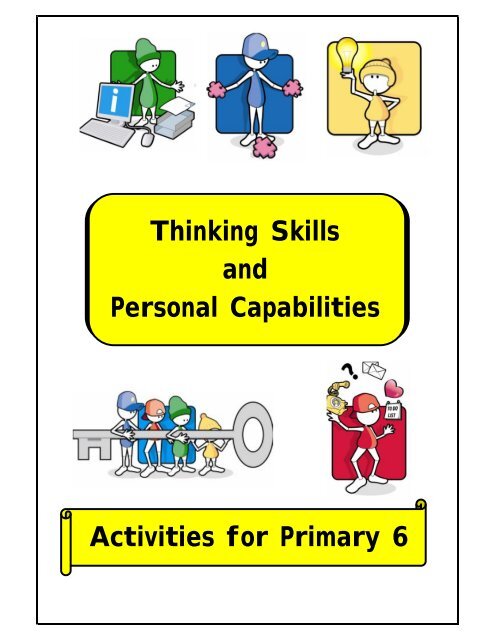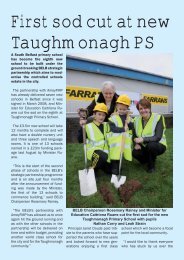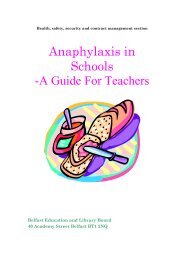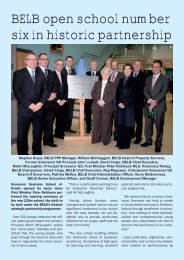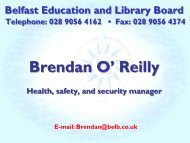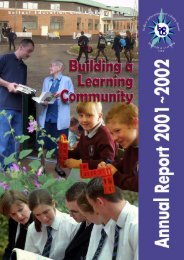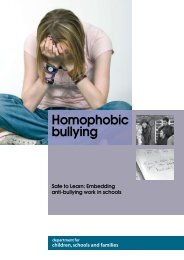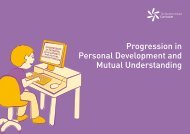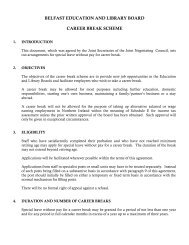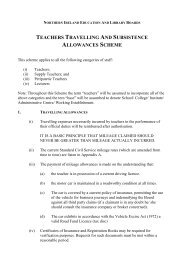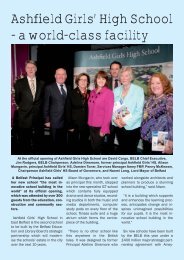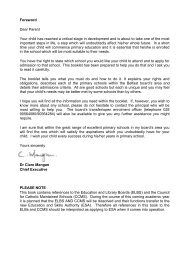Thinking Skills and Personal Capabilities Activities for Primary 6
Thinking Skills and Personal Capabilities Activities for Primary 6
Thinking Skills and Personal Capabilities Activities for Primary 6
- No tags were found...
You also want an ePaper? Increase the reach of your titles
YUMPU automatically turns print PDFs into web optimized ePapers that Google loves.
Areas of learning / <strong>Thinking</strong> <strong>Skills</strong> <strong>and</strong> <strong>Personal</strong> <strong>Capabilities</strong> ReferencesTitleArea of Learning<strong>Thinking</strong> <strong>Skills</strong> <strong>and</strong> <strong>Personal</strong><strong>Capabilities</strong>PageLanguage &LiteracyMathematics &Numeracy<strong>Personal</strong>Development &MutualUnderst<strong>and</strong>ingThe ArtsWorld AroundUsICTManagingIn<strong>for</strong>mation<strong>Thinking</strong>,Problem Solving& DecisionMakingBeing CreativeWorking withOthersSelfManagementEurovisionDecision4 Get In Order 18 AdditionSurvey22 Raiders(Extract A) 25 The Vikings inIrel<strong>and</strong>(Extract B)31 Viking Raids 41 Life Cycles 44 Water 48 Cinderella 56 Dance Off 61 Bibliography<strong>and</strong>ReferencesWebsites- 3 -
Title: Eurovision DecisionArea of Learning:Mathematics <strong>and</strong> NumeracyPossible Learning Intention:Use available clues to help present in<strong>for</strong>mation in a meaningful way.<strong>Thinking</strong> <strong>Skills</strong>/<strong>Personal</strong> <strong>Capabilities</strong>:Managing In<strong>for</strong>mation: Develop methods <strong>for</strong> collating <strong>and</strong> recordingin<strong>for</strong>mation.Working With Others: Work with their peers to reach agreementsActivity:The children have to use two different sets of clue cards to piece togetherin<strong>for</strong>mation to produce a “Top Ten” results table <strong>for</strong> the 2007 Eurovision SongContest <strong>and</strong> to solve problems based on a promotional tour <strong>for</strong> the Irishrepresentatives in the 2008 contest.Classroom Management:The pupils can work in pairs or groups of 3. They will need access to the cluecards, distance chart, a calculator <strong>and</strong> a political map of Europe showingcountries <strong>and</strong> capital cities. They will also need recording paper <strong>and</strong> pencil. Thepupils may benefit from regular review to discuss strategies <strong>and</strong> derived facts.How It Works:Challenge 11. Give each group a set of “2007 ESC Top 10 Cards”, country clues <strong>and</strong> a blankresults table. Explain that the pupils have to read the in<strong>for</strong>mation on thecards to help them produce the “top ten” results table <strong>for</strong> the 2007Eurovision Song Contest.Challenge 21. Using the country clues list, identify which letters represents which country2. Discuss what the pupils may need to help them (e.g. calculator, map ofEurope).3. Pupils work together in their group to produce the results table.- 4 -
Challenge 31. Give each group a set of “Irish Promotional Tour ESC 2008 Travel Cards”.Tell the pupils they must read the in<strong>for</strong>mation on the cards <strong>and</strong> answer thequestions on the question cards.2. Discuss what the pupils may need to help them (e.g. calculator, distancechart, map of Europe)3. Pupils work together in their group to produce solutions to the questioncards.Challenge 41. When the results of the Eurovision Song Contest 2008 are available (24May 2008) pupils can create a set of clue cards <strong>for</strong> a new “top ten” tablewhich other pupils can use.2. Pupils will need to spend some time planning how they will approach the task– roles within the group, in<strong>for</strong>mation they will need, etc.3. Pupils draft the set of cards <strong>and</strong> produce a final copy using ICT.Metacognition:In order <strong>for</strong> learners to strengthen their thinking strategies they need time toplan, adapt <strong>and</strong> evaluate their thinking (see Reflective <strong>Thinking</strong> Grid – page 2).Making Connections:• Produce profiles of the participating countries in Eurovision 2008 (TWAU –Geography)• Design a Logo <strong>for</strong> Eurovision 2008 (Art <strong>and</strong> Design)• Watch the previews of the songs (available online <strong>for</strong> download) <strong>and</strong> write areport including type of song, description of preview video, etc.(Language <strong>and</strong> Literacy).Useful Websites:The songs in the 2008 Eurovision Song Contest can be downloaded from thefollowing sites:■■■www.esctoday.comwww.allkindsofeverything.iewww.youtube.com- 5 -
Pupil Resource SheetEurovision 2007 Top Ten ResultsYou will need a set of cards on which you will find clues to help youpiece together in<strong>for</strong>mation to complete a table of results <strong>for</strong> theTop 10 per<strong>for</strong>ming countries in the Eurovision Song Contest 2007.Think about:‣ You have the set of clue cards. Do you need any furtherin<strong>for</strong>mation or equipment to help you complete the task?‣ How will you organise the in<strong>for</strong>mation that you have?‣ How will you record your work?Further Challenges‣ Find out the Top Ten results <strong>for</strong> the 2008 Eurovision SongContest final. Create a set of clue cards <strong>and</strong> present themto another group to trial them. Produce a final copy of yourcards using ICT so that they can be used as a problemsolvingactivity <strong>for</strong> another class.- 6 -
Eurovision Decision : Challenge 12007 ESC Top 10 CardsPupil Resource SheetCountry D achieved 5 th placing<strong>and</strong> scored 19 points more thancountry J.Country G finished in 4 thposition <strong>and</strong> achieved 24 pointsmore than country A.Read the in<strong>for</strong>mation on all ofthe cards <strong>and</strong> complete theEurovision 2007 Top Tenresults table.Country H achieved a score of145 points which was 36 pointshigher than the total score <strong>for</strong>country C.Country I was placed betweencountry E <strong>and</strong> country B <strong>and</strong>scored 96 points more thancountry AWhat was the range of scoresin the Top Ten results table?Country E scored more pointsthan any other country <strong>and</strong> wassix places above country A.Which two countries togetherscored a total of 380 points?- 7 -
Eurovision Decision : Challenge 12007 ESC Top 10 CardsPupil Resource SheetCountry B achieved 207 pointswhich was two places lower <strong>and</strong>61 points lower thancountry E.How many of the top tencountries achieved anodd total?Country J scored 69 points lessthan country B but was twoplaces abovecountry C.Country A achieved 139 points<strong>and</strong> was ranked 3 places abovecountry C.How many of the top tencountries achieved a totalwhich is a multiple of 3?Country H was two places lowerthan country G <strong>and</strong> achieved 7points more thancountry J.Country F was placed just belowcountry J <strong>and</strong> scored 107points less than the countryin 2 nd position.What was the total number ofpoints awarded to the top tencountries?- 8 -
Pupil Resource SheetEurovision 2007 Top Ten Results TablePOSITION LETTER COUNTRY SCORE12345678910- 9 -
Eurovision Decision : Challenge 2Pupil Resource SheetEurovision 2007 – Top Ten CountriesLETTER CLUE COUNTRYABCDEFGHIJThis country is due East of the southerntip of Italy across the Ionian Sea.This country has a border with Finl<strong>and</strong> <strong>and</strong>also with Latvia.This country is located between Romania<strong>and</strong> Ukraine.This country has a port called Varnu onthe Black Sea.This country is the host country <strong>for</strong>Eurovision 2008.This country is east of Austria, has aborder with Romania <strong>and</strong> has a capital citybeginning with B.This country has a long northern coastlineon the Black Sea.This country is the only country which hasa border with both Latvia <strong>and</strong> Lithuania.This country has a capital city called Kiev.This country is east of Turkey, South ofGeorgia, West of Azerbaijan <strong>and</strong> North ofIran.- 10 -
Eurovision Decision : Challenge 3Pupil Resource SheetIrish Promotional Tour ESC 2008In the 2007 Eurovision Song Contest Irel<strong>and</strong> achieved their mostdisappointing result ever coming last in the contest with just 5 points.This year the television broadcaster RTE want to do everything possibleto achieve a better result so they have decided to provide funding <strong>for</strong> apromotional tour which will allow the Irish song to be heard in severalcountries be<strong>for</strong>e the contest takes place.Details of the tour are provided on the travel cards. The tour begins <strong>and</strong>ends in Dublin. Your task is to provide solutions to any of the travel cardswhich contain questions.:Think about‣ You have the set of travel cards. Do you need any furtherin<strong>for</strong>mation or equipment to help you complete the task?‣ How will you organise the in<strong>for</strong>mation that you have?‣ How will you record your work?Further Challenges‣ Work out a way in which the Irish Representative, DustinThe Turkey, can visit all the countries on the tour bycovering the least distance possible.‣ The European Broadcasting Union has decided to establishnew Headquarters in one of the 12 cities. The city which willbe chosen is the one which will require the shortest totaldistance <strong>for</strong> all of the other 11 countries to reachHeadquarters. Which city will be chosen?- 11 -
Eurovision Decision : Challenge 3Irish Promotional Tour ESC 2008 Travel CardsPupil Resource SheetSlovenia is the destination hereaches after his four day visitto France.After spending 4 days in theUnited Kingdom he flies toBelarus where he spends twodays.On what date does thepromotional tour end?From Estonia he flies on toSpain.Two days later he leavesIcel<strong>and</strong> <strong>and</strong> flies to Austriawhere he spends 3 days.On 7 th March 2008 Dustin TheTurkey leaves Dublin <strong>and</strong> fliesto Estonia where he spends 2days.United Kingdom is thedestination after Austria.When the tour reached Belarus,how many kilometres had beentravelled?- 12 -
Eurovision Decision : Challenge 3Irish Promotional Tour ESC 2008 Travel CardsPupil Resource SheetTwo days after arriving inSlovenia he flies back to Dublin.He spends just one day inCroatia be<strong>for</strong>e flying toIcel<strong>and</strong>.On 14 th March he goes into arestaurant to buy a meal. Hepays the bill using the localcurrency. What currency didhe use?After spending three days inSpain he travels on to Croatia.After just one day in Cyprusthe tour continues in Finl<strong>and</strong>.How many kilometres did DustinThe Turkey fly during theentire tour?He stays <strong>for</strong> three days inFinl<strong>and</strong> <strong>and</strong> then flies toFrance.From Belarus he flies on toCyprus.- 13 -
Eurovision Decision : Challenge 3Pupil Resource Sheet- 14 -
Eurovision Decision : Challenge 3Pupil Resource Sheet- 15 -
Teacher In<strong>for</strong>mationEurovision 2007 Answer SheetPOSITION LETTER COUNTRY SCORE1 E Serbia 2682 I Ukraine 2353 B Russia 2074 G Turkey 1635 D Bulgaria 1576 H Belarus 1457 A Greece 1398 J Armenia 1389 F Hungary 12810 C Moldova 109Challenge 1. Answers to additional questions: 2 of the top ten countries achieved a total which is a multiple of 3 Countries I <strong>and</strong> H achieved a total of 380 points 7 countries scored an odd total The range of top ten results was 159 points Total points awarded to top ten countries was 1689- 16 -
Teacher In<strong>for</strong>mationEurovision Decision : Challenge 3Irish Promotional Tour ESC 2008SOLUTIONSQuestion CardsWhen the tour reached Belarus, how many kilometres had beentravelled? Answer : 15654 kilometresHow many kilometres did Dustin The Turkey fly during the entiretour? Answer : 25189 kilometresOn 14 th March he went into a restaurant to buy a meal. Whatcurrency did he use? Answer : Icel<strong>and</strong>ic Krona (plural – kronur)On what date does the promotional tour end? Answer : 3 rd April2008Further Challenges‣ The shortest distance to visit all 12 cities is 12690 kilometresRoute is Dublin – Reykjavik – Helsinki – Tallinn – Minsk – Nicosia– Zagreb – Ljubljana – Vienna – Madrid – Paris – London –Dublin‣ The city chosen as EBU Headquarters would be Vienna. The totaldistance from all 11 cities to Vienna is 14988 kilometres.- 17 -
Title: Get In Order!Area of Learning:Mathematics <strong>and</strong> NumeracyPossible Learning Intention:Explore <strong>and</strong> order fractions<strong>Thinking</strong> <strong>Skills</strong>/<strong>Personal</strong> <strong>Capabilities</strong>:<strong>Thinking</strong>, Problem-Solving <strong>and</strong> Decision-Making:Identify <strong>and</strong> order patterns <strong>and</strong> relationships through a range of strategies.Self Management:Become self-directed by working on their own or with a group.Activity:The activity challenges the children to compare the size of fractions of a rangeof fraction families.Classroom Management:The activity can be carried out with a partner or working in a small group.Dominoes with a blank should be removed be<strong>for</strong>e the activity starts (this mayprovide some useful discussions within/between groups).How It Works:The children use a selection of dominoes – working either as a large group or in2s/3s.Each domino should be considered as a fraction <strong>and</strong> placed on the blanknumberline (0 to 1).Children should be encouraged to justify their placement of each domino (e.g.“this 2/3 goes here because it is larger than a half, but less than 1”).The activity encourages the players to compare <strong>and</strong> order fractions, articulatingtheir reasoning <strong>and</strong> justifying their fraction placement.Possible modifications:• Use a 0-6 numberline <strong>and</strong> ask the children to invert their dominoes (e.g.2/3 becomes 3/2) – order the fractions as be<strong>for</strong>e.• Turn the dominoes sideways to represent a decimal on the 0-6 number line(5/4 becomes 5.4), then order as be<strong>for</strong>e.• Predict whether the next (unseen) domino is higher or lower than the lastchosen (brings in notion of probability too).- 18 -
• Other work with blank number line involving thous<strong>and</strong>s. Numbers can begenerated by using two dominoes or four dice.Metacognition:In order <strong>for</strong> learners to develop <strong>and</strong> strengthen their thinking strategies theyneed time to plan, adapt <strong>and</strong> evaluate their thinking. The justification offraction placement is the key to this activity – children should be encouraged toidentify other situations where it is necessary to justify decisions.Making Connections:• Using a historical timeline, with significant dates (TWAU)- 19 -
- 20 -
Number Lines0 10 6- 21 -
Title: Addition SurveyArea of Learning:Mathematics <strong>and</strong> NumeracyPossible Learning Intention:Collect, collate <strong>and</strong> analyse in<strong>for</strong>mation regarding mental mathematics.<strong>Thinking</strong> <strong>Skills</strong>/<strong>Personal</strong> <strong>Capabilities</strong>:Managing In<strong>for</strong>mation: Use a range of methods <strong>for</strong> collating, recording <strong>and</strong>representing in<strong>for</strong>mationSelf-management: Organise <strong>and</strong> plan how to go about a task.Activity:This activity will focus on planning <strong>and</strong> collating in<strong>for</strong>mation on how people carryout mental calculations involving addition.Classroom Management:The children work in small groups to discuss methods <strong>and</strong> work individually or inpairs to carry out research.How It Works:The children are presented with the task (see Pupil Resource Sheet) <strong>and</strong> aregiven planning time. The task is to see how most people will do six given additioncalculations. The children have to time each person, record the methods used<strong>and</strong> their age group. The children have to decide how to finally represent theirresults <strong>and</strong> see if there are common methods of calculations in each age group.Metacognition:In order <strong>for</strong> learners to develop <strong>and</strong> strengthen their thinking strategies theyneed time to plan, adapt <strong>and</strong> evaluate their thinking (see Reflective <strong>Thinking</strong>Grid).Making Connections: Looking at how people in different age groups approach tasks. Collecting raw data in any area of learning.- 22 -
Pupil Resource SheetAddition SurveyYou are going to carry out a survey to find out how most people doaddition calculations.Give as many people as possible the following six sums to do:3 + 18 =24 + 25 =4 + 8 + 9 + 2 + 6 =76 + 68 =448 + 297 =£1.99 + £1.99 + £1.99 =Tell the people in your survey that they can try to do thecalculations “in their head” or they can use pencil <strong>and</strong> paper.Record how long they take to do the sums <strong>and</strong> what method they use.Try to get each person to explain to you how they per<strong>for</strong>med each ofthe calculations.Bring all of the results of your survey into school.In a small group, discuss what you found out from your survey <strong>and</strong>how you could present the results.- 23 -
Pupil Resource SheetAddition SurveyCalculation Answer Method3 + 1824 + 254 + 8 + 9 + 2 + 676 + 68448 + 297£1.99+£1.99+£1.99Time Taken :Working Out :Age Group ofperson :6 – 1516 – 2526 – 3536 – 4546 – 5556 – 6566 – 75over 75- 24 -
Title: RaidersArea of Learning:Language <strong>and</strong> LiteracyPossible Learning Intentions:Be able to ask <strong>and</strong> answer focused questionsBe able to listen to a text <strong>and</strong> give a personal responseBe able to identify <strong>and</strong> empathise with the thoughts <strong>and</strong> feelings of a character<strong>Thinking</strong> <strong>Skills</strong>/<strong>Personal</strong> <strong>Capabilities</strong>:Being Creative: Experiment with different modes of thinkinge.g. visualisationWorking with Others: Listen actively <strong>and</strong> share opinions with othersActivity:After the teacher reads a text to the class the children interpret theirunderst<strong>and</strong>ing of the thoughts <strong>and</strong> feelings of the characters throughquestioning <strong>and</strong> drama. Teachers may choose some/all of the activities outlinedin the ‘How It Works’ section.Classroom Management:Small groupsHow It Works:1. The teacher reads <strong>and</strong> discusses the story with the children, perhaps in ashared reading session.2. Using the ‘I Wonder’ sheet, children are given the opportunity to give apersonal response to the text by <strong>for</strong>mulating their own questions.3. Identify one scene from the story, <strong>for</strong> example : from “There are menfighting everywhere” – “Look out!”4. In groups of 3-4 the children make a still tableau with each person in thegroup representing one character, creating a frozen moment from this scene.Allow time <strong>for</strong> discussion of characters, their personalities, thoughts <strong>and</strong>feelings, <strong>and</strong> trying out. Then on signal, “freeze”, all groups hold their positions.5. When all are still, the teacher moves around <strong>and</strong> touches a character fromthe groups in turn. On being touched each “character” speaks out the thoughtsin their heads at that moment (in role). e.g. The teacher says “At that moment Ithought to myself . . .”- 25 -
6. After a number of participants have had the opportunity to speak, theteacher can also ask some groups to demonstrate their “frame” <strong>and</strong> then comeout of role <strong>and</strong> explain why the group decided to depict the scene in the waythey did <strong>and</strong> how others might have depicted it differently, explain what theythought the characters were feeling or what they might do next. Other childrencould ask questions of the group or individual characters. Groups could thenimprove their frame as a result of the discussion.Metacognition:In the plenary discuss the thinking skills children are developing while they areparticipating in the task. For example : reflect, empathise, justify or givereasons, predict, identify thoughts <strong>and</strong> feelings, respond , imagine.This activity encourages children to think more deeply about the characters <strong>and</strong>express their thoughts in actions <strong>and</strong> words. Encourage them to reflect on howwell they were able to empathise, thinking about the text <strong>and</strong> by using theirimagination to build on the clues in the text.Children could also reflect on <strong>and</strong> evaluate their own contribution to the group<strong>and</strong> how well they worked together as a group.Making Connections:Freeze frames can be created using:• Stories, Poems, Picture books, Fables (Language <strong>and</strong> Literacy)• Paintings (The Arts – Art <strong>and</strong> Design)• Photographs or historical accounts of events or places (TWAU)• Environmental or moral issues, eg from news articles (RE, PDMU orTWAU).For further ideas <strong>and</strong> explanation of the approach:Active Learning <strong>and</strong> Teaching Methods Booklet (page 30) CCEA<strong>Thinking</strong> It Through: Developing Language <strong>and</strong> Numeracy <strong>Skills</strong> Through<strong>Thinking</strong> <strong>and</strong> Drama <strong>Activities</strong> Gill Thompson & Huw Evans- 26 -
EXTRACT ARAIDERS(When Jack Watson sleeps in an old tent in the garden he goes through a time-slip <strong>and</strong>finds himself back in the time of the Viking raids. His name is Edric <strong>and</strong> he <strong>and</strong> hissister Elfreda are the children of a brave Saxon chief).As soon as I was inside the tent, I lay down <strong>and</strong> closed my eyes.It is cool, dark <strong>and</strong> silent. No birds are singing. It is early dawn <strong>and</strong> I am on my way tothe riverbank looking <strong>for</strong> firewood. I should have collected it yesterday, but I <strong>for</strong>got.When I reach the high ground, overlooking the river, I look down.Then I freeze.A long narrow boat, with a dragon’s head on the front, is gliding silently along. Thereare round metal things hanging over the sides, <strong>and</strong> I realise they are shields. The oarsdip in <strong>and</strong> out of the water without a sound. My mouth goes dry. I am almost tooterrified to move, but some instinct warns me to drop to my stomach, out of sight. Icrawl to the edge <strong>and</strong> watch. The boat pulls up by the bank. It is full of huge men, withlong fair hair underneath iron helmets.Raiders!They are quiet, intent <strong>and</strong> menacing. I have never seen so many men make so littlenoise.With hardly a sound, they spill out of the boat, lifting off their round shields to takewith them. They are all carrying axes <strong>and</strong> swords. They look like giants. Then theybegin to creep purposefully towards the village. My village, where Father <strong>and</strong> Mother<strong>and</strong> Elfreda are asleep.And I remember what the stranger told us about the terrible things the raiders haddone in his village. I am horribly afraid. I reach <strong>for</strong> my wooden swallow. I need it nowto bring me luck. It is not there. I must have <strong>for</strong>gotten to pick it up. It must be in thehut. I try not to think of this as an ill omen.Trying desperately to keep out of sight, I wriggle backwards until I cannot see theraiders any more. Then I leap to my feet <strong>and</strong> start to run, faster than I have ever runin my life. My feet skim over the rough grass.My heart is pounding, <strong>and</strong> I am terrified, but I dare not stop. I have to warn them.Only when I reach the fence do I dare to look over my shoulder. The raiders are not in- 27 -
sight yet, but I know they cannot be far behind. I run inside <strong>and</strong> bar the gate. Then Irace to the nearest hut <strong>and</strong> bang on the door.“Raiders!” I shout. “Help! Raiders! Help!”I don’t wait <strong>for</strong> an answer, but run to the next hut.“Raiders!”I can hear people stirring behind me as I race through the village. I cannot stop until Ihave warned Father.Suddenly I hear a loud splintering noise behind me as the raiders attack the gate withtheir axes. Then they surge into the village, with terrible, bloodcurdling cries.As I reach our hut, the door opens <strong>and</strong> Father comes out br<strong>and</strong>ishing his sword.“Well done, Edric,” he cries. “We’re ready <strong>for</strong> them!”Then I realise everyone is awake. There is a lot of shouting <strong>and</strong> the clash of swords <strong>and</strong>spears. We Anglo-Saxons may not be as big as them, but we are fierce when we’rethreatened. We won’t give in without a fight.“Look after your mother <strong>and</strong> sister, Edric” calls Father as he charges into the battle.The noise is deafening now. I turn <strong>and</strong> see the other women <strong>and</strong> children huddled atthe fence, away from the fighting.Mother <strong>and</strong> Elfreda are in the hut. Mother is looking desperately worried, but Elfreda’seyes are sparking with excitement. “I want to join in!” she says.“Oh Elfreda!” I say, exasperated, as I hurry them out of the hut.Then Elfreda sees what is happening, <strong>and</strong> hears all the shouting <strong>and</strong> the fearful clashingof weapons. She picks up a stout stick <strong>and</strong> as we reach the others she says bravely,“Don’t worry about us, Edric. I’ll look after Mother <strong>and</strong> the other children.” And Iknow she won’t give in without a fight, either.“I must go <strong>and</strong> help Father!” I cry, <strong>and</strong> hurry off to find him.There are men fighting everywhere, but I can’t see Father. Then a huge h<strong>and</strong> isclamped over my mouth. I struggle <strong>and</strong> find myself in the grip of an enormous raider.He is incredibly strong <strong>and</strong> I am paralysed with terror. I cannot even scream. Andsuddenly Father is here. His sword is battered <strong>and</strong> has smears of blood on it. I havenever seen him look so fierce. “Leave my son alone!” he bellows, charging at the man.- 28 -
With a roar, the raider pushes me aside <strong>and</strong> turns to Father. He has a heavy axe in hish<strong>and</strong>. He whirls it round his head. The axe cuts the sword in two, as if it was no morethan a twig. Father is left holding the stump as the Viking lifts his axe again.“Father!” I scream. “Look out!”Father dodges as the axe falls where his head would have been. But the axe has caughthis shoulder, <strong>and</strong> I see blood spurt out from the deep wound. His sword arm dangles,useless. I must help him. What can I do?Then I remember my lucky swallow, still in the hut. It is my last hope. But as I turn, Isee our roof is now alight. I must hurry.I dive in, snatch up my swallow from the bench, when I see the raider raise his axeagain.I am so angry I don’t stop to think. I st<strong>and</strong> in the doorway <strong>and</strong> fling the wooden swallowat him with all my might. To my great satisfaction it hits him on the <strong>for</strong>ehead.Startled, he staggers back <strong>and</strong> drops the axe. Father grabs it.“Well done Edric!” he says, glancing over his shoulder at me.Then his eyes widen with horror.“The roof!” he cries. “Look out!”But be<strong>for</strong>e I can move, everything goes black.Extract taken from Raiders by Lynne BentonPublished by Heinemann- 29 -
Pupil Resource SheetI Wonder….- 30 -
Title: The Vikings in Irel<strong>and</strong>Area of Learning:Language <strong>and</strong> LiteracyPossible Learning Intentions:Compare <strong>and</strong> contrast using similarities <strong>and</strong> differences.Underst<strong>and</strong> that authors will use different writing styles depending on theaudience <strong>and</strong> purpose.<strong>Thinking</strong> <strong>Skills</strong>/<strong>Personal</strong> <strong>Capabilities</strong>:<strong>Thinking</strong>, Problem Solving <strong>and</strong> Decision Making: Pupils will compare <strong>and</strong>contrast effectively.Being Creative: Generate, combine ideas <strong>and</strong> opinionsActivity:Pupils will examine the way in which authors use different writing stylesdepending on the purpose <strong>and</strong> audience.Classroom Management:The children work in small groups to discuss <strong>and</strong> analyse the two extracts. Eachgroup will be provided with one A3 copy of the ‘compare <strong>and</strong> contrast’ thinkingframe <strong>and</strong> one A4 copy of the ‘story elements’ sheet per group.How It Works:The children have access to both extracts <strong>and</strong> the teacher has a flexible set ofnotes <strong>for</strong> the lesson. The teacher notes provide further guidance <strong>and</strong> keyquestions the teacher may wish to ask. The children also have a thinking framewhich identifies the criteria upon which they should compare <strong>and</strong> contrast theextracts. Finally the children are encouraged to think about which extract wouldbe better at in<strong>for</strong>ming a third party about the Vikings.Metacognition:In order <strong>for</strong> learners to strengthen their thinking strategies they need time toplan, adapt <strong>and</strong> evaluate their thinking (see Reflective <strong>Thinking</strong> Grid – page 2).Making Connections:Comparing <strong>and</strong> contrasting two characters from stories to underst<strong>and</strong> how thetwo characters responded differently to conditions in the story.(Language <strong>and</strong> Literacy)- 31 -
NOTES <strong>for</strong> TEACHERS(Please note that the print in bold provides a possible teacher script)INTRODUCTIONThink about a time when you heard a story that was similar to one youalready knew. Try to recall the similarities that reminded you that you hadheard a story like this be<strong>for</strong>e.What were some of the differences between the two stories?When you noticed similarities <strong>and</strong> differences, you were “comparing <strong>and</strong>contrasting.”We’re going to read extracts from two different stories which are aboutthe Vikings.THINKING ACTIVELYRead the two extracts <strong>and</strong> compare <strong>and</strong> contrast them using the thinkingdiagram. Identify similarities <strong>and</strong> record them in the ‘How alike?’ section.Then look <strong>for</strong> ways in which the two extracts are different <strong>and</strong> record themunder ‘How different?’Write the differences on the lines under ‘How different?’For example, ‘The Vikings in Irel<strong>and</strong>’ by Morgan takes place on a Viking longboat whereas ‘Raiders’ by Lynne takes place on l<strong>and</strong> in Anglo Saxon days.The term which describes this difference is SETTING.In order to structure children’s thinking, teachers may wish to select from someor all of the following characteristics using the prompt questions.Think about the following differences as you read through both stories usingthe questions to help you.SETTINGWhere <strong>and</strong> when is the story located – past, present, future, real orimaginary world?How has the author created the setting? eg by describing it or throughdialogue between characters.CHARACTERWho are the characters in the story (can you name them)?How would you describe them?PLOT/CONTENTWhat happens in the passage?What are the key events?- 32 -
POINT OF VIEWWhat do the characters in the story think?What do the other characters think?LANGUAGE/DIALOGUEWhich tense is used?How are the sentences written?What punctuation is used? Why?What speech is included?PURPOSE/AUDIENCEWho was the author writing <strong>for</strong>?Why did they choose to write in this style?How are the stories alike? After they have finished reading the story, ask 4 or5 pupils to report one similarity they have found. Record their responses on aflipchart or A3 version of the thinking frame. Draw out the pupils thoughts byasking <strong>for</strong> clarification or extension of the answers, etc.POSSIBLE ANSWERS: Both extracts are written <strong>for</strong> children. Raiders in bothstories are Vikings <strong>and</strong> there are descriptions of Viking boats in each. Bothextracts have the same title. They both take place at the coast. A child is thekey character in both extracts <strong>and</strong> the stories are written from a child’s pointof view. We learn about the feelings of the key characters. Weapons areincluded in each extract <strong>and</strong> these are used <strong>for</strong> fighting <strong>and</strong> attacking byraiders.How are the stories different? (Record differences on A3 version)POSSIBLE ANSWERS:SETTING:Extract A – ‘Raiders’ by Lynne – set in an old tent in the garden - in his dream -set on l<strong>and</strong> in Anglo Saxon times <strong>and</strong> happens on one day. Set in the present witha time-slip.Extract B – ‘The Vikings in Irel<strong>and</strong>’ by Morgan - set on a Viking longship <strong>and</strong>takes place over a period of years.CHARACTERExtract A – ‘Raiders’ by Lynne – key character is Jack Wilson. In his dream hebecomes Edric, an Anglo Saxon child. There are 4 named characters. Edric, hissister Elfreda, his Father <strong>and</strong> Mother.Extract B – ‘The Vikings in Irel<strong>and</strong>’ by Morgan – key character is a Viking Raiderwho is a child.- 33 -
PLOT/EVENTSExtract A – ‘Raiders’ by Lynne – Boy falls asleep. Raiders arrive on the shore. Heruns to warn his father. Raiders attack the village. He warns his family. Edric iscaptured by a raider. Father attempts to rescue him <strong>and</strong> is injured. Edric throwshis swallow at the raider. Father shouts warning.Extract B – ‘The Vikings in Irel<strong>and</strong>’ by Morgan – Boy is on longship. Facts aboutViking life – boat building, trading, beginning of raiding. Other Viking l<strong>and</strong>s.Discovery of Irel<strong>and</strong>. Return to narrative of Viking child.POINT OF VIEWExtract A – ‘Raiders’ by Lynne – written from a Anglo Saxon child’s point of view.Extract B – ‘The Vikings in Irel<strong>and</strong>’ by Morgan - written from the Viking point ofview.LANGUAGE/DIALOGUEExtract A – ‘Raiders’ by Lynne – written in the 1 st person in narrative, recountstyle. Present tense. Includes much shorter sentences <strong>and</strong> a greater variety ofpunctuation is included. Action verbs used are stronger <strong>and</strong> more powerful.Includes a considerable amount of dialogue.Extract B – ‘The Vikings in Irel<strong>and</strong>’ by Morgan - written mainly in the past tense,3 rd person. The sentences are much longer <strong>and</strong> include many more connectives.There is no dialogue.PURPOSE AND AUDIENCEExtract A – ‘Raiders’ by Lynne – fiction text written to excite <strong>and</strong> involve thereader <strong>and</strong> to tell a story.Extract B – ‘The Vikings in Irel<strong>and</strong>’ by Morgan – non-fiction text written toin<strong>for</strong>m children about the Vikings.Now let’s think about the similarities <strong>and</strong> differences on your diagram.There are many true things that we could say about the two stories thatmay not be very important. For example, both stories are written <strong>for</strong>children. However, many stories are written <strong>for</strong> children. That similaritydoes not tell us anything important about these two stories. We want tobase our underst<strong>and</strong>ing of the stories on factors that are important. Drawa line through any similarities <strong>and</strong> differences that are not important.Now let’s think about something interesting that you have learned about thetwo stories based on your comparing <strong>and</strong> contrasting. What do thesimilarities <strong>and</strong> differences you have noted tell you about the way in whichauthors use different writing styles depending on the audience <strong>and</strong> purpose?In the bottom box, write one sentence that expresses a conclusion, thinking- 34 -
about which text you think would be most useful if you were telling someoneabout the Vikings <strong>and</strong> why.THINKING ABOUT THINKINGLet’s focus our attention on how we thought about the two extracts.The kind of thinking we did was called ‘comparing <strong>and</strong> contrasting’.What did we do to compare <strong>and</strong> contrast?How did the way we compared <strong>and</strong> contrasted the extracts differfrom the way we usually read stories in class?Did the thinking frame help in any way?Do you think this was a valuable way to think about the two extracts?APPLYING THINKINGCompare <strong>and</strong> contrast two characters from stories you have read recently tounderst<strong>and</strong> how the two characters responded differently to conditions inthe story.- 35 -
EXTRACT BThe Vikings in Irel<strong>and</strong>The dragon-headed longship came nosing out of the sea mist. Oars rose <strong>and</strong> fellin rhythm. The boy st<strong>and</strong>ing in the prow of the longship had blond hair <strong>and</strong> blueeyes that glittered with excitement. He was the captain’s son <strong>and</strong> this was thefirst time to ‘go viking’.To go viking meant to go sea-raiding. A longship with a square sail <strong>and</strong> oars couldtravel anywhere there was enough water. The Sc<strong>and</strong>inavian l<strong>and</strong> we know todayas Norway had many miles of coastline <strong>and</strong> the people who lived there looked tothe sea <strong>for</strong> support. They also farmed, although farming was not easy in theirclimate; the summers were short <strong>and</strong> winters were long. Not every crop wouldgrow in l<strong>and</strong> where some of the ground was too steep or too rocky to plough.The Norsemen were almost totally dependent upon fishing to support themselves<strong>and</strong> their families. Life was hard.From the earliest times, Sc<strong>and</strong>inavian people had built boats. At first theirboats were dugout canoes, made from hallowing out a single tree-trunk. Theyalso made boats of hides which were stretched over wooden frames <strong>and</strong> lashedtogether with leather thongs. These were simple fishing boats <strong>and</strong> were used totravel only short distances. But as time passed, they learned to build largervessels. These then made it possible <strong>for</strong> them to take longer voyages <strong>and</strong>explore the seas around them.They discovered that people in other l<strong>and</strong>s conducted extensive trade,exchanging their goods <strong>and</strong> produce <strong>for</strong> other items they needed or wanted.Some of these items were luxury goods, things Sc<strong>and</strong>inavian people did not have<strong>and</strong> they wanted to take part in trade too. But they were not wealthy, beingbarely able to feed <strong>and</strong> clothe themselves, <strong>and</strong> did not have much surplus <strong>for</strong>their traders to use. Still, they sent ships out along the trade routes <strong>and</strong> did asmuch business as they could.- 36 -
It was not long be<strong>for</strong>e the Norsemen began plundering their neighbours. It mayhave begun almost by accident, with men in a boat running out of supplies <strong>and</strong>putting ashore to steal what they needed from some coastal settlement. Butbe<strong>for</strong>e long they realised that sea-raiding could provide them with a whole newsource of wealth.Soon armed adventurers were attacking settlements all around the North Sea.These were not peaceful traders, but wild <strong>and</strong> reckless men. As they met withincreasing success, they became bolder <strong>and</strong> bolder. They killed any defendersthey found, stole their valuables <strong>and</strong> captured women <strong>and</strong> children to sell asslaves.Norway was not the only home of sea-raiders. The success of the Norseencouraged shipowners from the more fertile l<strong>and</strong> of Denmark – the Danes – togo Viking too. Other raiders came from the Hebrides <strong>and</strong> the Orkney Isl<strong>and</strong>s.They all belonged to the Sc<strong>and</strong>inavian race, <strong>and</strong> thought of themselves asNorthmen. But the people who learned to fear them called them … Vikings.In AD 795 a Viking longship had approached the coast of Irel<strong>and</strong> <strong>for</strong> the firsttime. Those aboard observed that much of the l<strong>and</strong> was covered with <strong>for</strong>ests.When they got back to Norway, the adventurers talked excitedly of the greenisl<strong>and</strong> they had found, where great trees grew, as timber was a valuable ship –building commodity.The longship in which the Norse boy rode was the second to visit Irel<strong>and</strong>,arriving in AD797. As they left the bank of mist behind, he squinted against theglare of reflected light from the sea. Ahead of them he saw several offshoreisl<strong>and</strong>s. On the nearest, he could make out a stone chapel <strong>and</strong> a cluster of round,wattle-<strong>and</strong>-timber buildings. Although the boy did not realiseit, the buildings were part of a Christian monastery on theisl<strong>and</strong> now known as Lambay, off the coast of Skerries in northCounty Dublin.The oarsmen put their backs into their rowing <strong>and</strong> the longshipsped <strong>for</strong>ward like a seabird. The boy listened with pleasure to- 37 -
the hiss of the sea rushing past. With one h<strong>and</strong> he reached out <strong>and</strong> stroked thedeeply carved, brightly painted prow. It looked like a ferocious dragon rising outof the waves. The sight of the prow struck terror into the hearts of l<strong>and</strong>people, but he knew the dragon as a friend. He had watched his father <strong>and</strong>older brothers carve <strong>and</strong> paint the wood themselves. Together with theirkinsmen they had built the longship on the shores of their fjord: a deep, narrowsea inlet. One lay just below their farm.Extract taken from: ‘The Vikings in Irel<strong>and</strong>’ by Morgan LlywelynISBN : 0862784212 Published by O’Brien.- 38 -
Pupil Resource SheetCOMPARE AND CONTRAST – THINKING FRAME‘Raiders’by Lynne Benton‘The Vikings in Irel<strong>and</strong>’by Morgan LlywelynHow alike?How different?SettingCharacterPlot.Point ofviewLanguage/DialoguePurpose/AudienceWhich text do you think would be most useful if you were tellingsomeone about the Vikings? Why?- 39 -
Pupil Resource SheetSTORY ELEMENTSSETTINGWhere <strong>and</strong> when is the story located – past, present, future,real or imaginary world?How has the author created the setting? eg by describing itor through dialogue between characters.CHARACTERWho are the characters in the story (can you name them)?How would you describe them?PLOT/CONTENTWhat happens in the passage?What are the key events?POINT OF VIEWWhat do the characters in the story think?What do the other characters think?LANGUAGE/DIALOGUEWhich tense is used?How are the sentences written?What punctuation is used? Why?What speech is included?PURPOSE/AUDIENCEWho was the author writing <strong>for</strong>?Why did they choose to write in this style?- 40 -
Title: Viking RaidsArea of Learning: The World Around UsPossible Learning Intention:Be able to identify long <strong>and</strong> short term consequences of Viking Raids<strong>Thinking</strong> <strong>Skills</strong>/<strong>Personal</strong> <strong>Capabilities</strong>:<strong>Thinking</strong> Problems Solving <strong>and</strong> Decision Making:Examine evidence <strong>and</strong> make links between possible causes <strong>and</strong> effectsWorking with Others: Be able to work with peers to reach agreements <strong>and</strong>manage disagreements.Activity:Identifying short <strong>and</strong> long term effects of Viking Raids <strong>and</strong> placing them on aripple diagram.Classroom Management:The activity can be carried out by pairs or small groups.How It Works:Children will underst<strong>and</strong> how to use ripple diagrams -(see Active Learning booklet Curriculum Support box)Children will have completed some work on the Vikings <strong>and</strong> in groups/pairsdiscuss, <strong>and</strong> record, the possible consequences of Viking Raids.Groups/pairs share <strong>and</strong> compare lists in order to agree a common list ofconsequences; these can be written on cards/slips of paper.Groups/pairs decide which are short/long term consequences <strong>and</strong> place in theappropriate circle on the diagram.The groups/pairs report back to each other debating <strong>and</strong> justifying theirchoices.Metacognition:In order <strong>for</strong> learners to strengthen their thinking strategies they need time toplan, adapt <strong>and</strong> evaluate their thinking (see Reflective <strong>Thinking</strong> Grid – page 2).Making Connections:• Cutting down rain<strong>for</strong>ests (TWAU)• Decision of Prodigal Son to take his inheritance (RE)• Consequences of stealing or smoking (PDMU).- 41 -
Pupil Resource SheetRipple Diagram : Viking RaidsThe words below show some of the possible consequences of Viking RaidsPlace the words on the ripple chart.Place the short term consequences near the centre of the chart.Place the words describing long term consequences nearer the outside of thechart.LootingBetter housingDifferent foodsDeathTradingNew fashionsHouses burnedNew religionHungerAngerNew townsViking words used in EnglishChange in lawsStolen children- 42 -
Pupil Resource SheetRipple DiagramWhat were the effects of the Viking raids?- 43 -
Title: Life CyclesArea of Learning:Language <strong>and</strong> LiteracyPossible Learning Intentions:Write <strong>for</strong> a variety of purposes <strong>and</strong> audiences, selecting, planning <strong>and</strong> usingappropriate style <strong>and</strong> <strong>for</strong>m.<strong>Thinking</strong> <strong>Skills</strong>/<strong>Personal</strong> <strong>Capabilities</strong>:Managing In<strong>for</strong>mation: Communicate with a sense of audience <strong>and</strong> purpose.<strong>Thinking</strong>, Problem-Solving <strong>and</strong> Decision-Making:Examine options <strong>and</strong> weigh up pros <strong>and</strong> cons.Activity:Use in<strong>for</strong>mation to label a cyclical diagram. The diagram is to be used byyounger children so it is important to make sure the labels are written <strong>for</strong> theappropriate age group.Classroom Management:Groups of two or moreHow It Works:• Look at a collection of in<strong>for</strong>mation books aimed at children aged 9-11 <strong>and</strong>compare them with books written <strong>for</strong> 4-5 year olds. Discuss the differencesin the language <strong>and</strong> layout, e.g. text size, amount of text, pictures <strong>and</strong> use oftechnical language.• Explain that they are going to consider this in more detail by analyzing a text<strong>for</strong> older children <strong>and</strong> making it applicable <strong>for</strong> a younger child.• In groups give the children a copy of the text (Pupil Resource Sheet – LifeCycle of the Frog) to read <strong>and</strong> discuss its suitability <strong>for</strong> younger children.• Share the cyclical diagram (Pupil Resource Sheet). How might this be used topresent the in<strong>for</strong>mation to younger children? Why is it called a ‘cyclicaldiagram’? Do pictures help younger children underst<strong>and</strong> the text? Would achild unable to read still get in<strong>for</strong>mation from this diagram?- 44 -
Use the in<strong>for</strong>mation to label the cyclical diagramWhole class evaluation on group diagrams, with reference to vocabulary <strong>and</strong>sentence structureMetacognition:In order <strong>for</strong> learners to strengthen their thinking strategies they need time toplan, adapt <strong>and</strong> evaluate their thinking (see Reflective <strong>Thinking</strong> Grid – page 2).Making Connections:• Persuasive writing – debating or advertising (Language <strong>and</strong> Literacy)• Write <strong>and</strong> illustrate a story book <strong>for</strong> younger children (Language <strong>and</strong>Literacy/The Arts)• Characters/from history or fiction – alternative scenarios <strong>and</strong> or events(TWAU/Language <strong>and</strong> Literacy).- 45 -
Pupil Resource SheetLIFE CYCLE OF THE FROGRead the text below.Frogs are amphibians – animals that are capable of living onwater <strong>and</strong> on l<strong>and</strong>. Frogs lay eggs in water because they areprone to desiccation. Their eggs are also surrounded by ajelly-like substance which ensures the developing embryo willhave the necessary energy <strong>for</strong> growth.The eggs hatch into fish-like, swimming creatures calledtadpoles. These tadpoles have external gills <strong>and</strong> suckers toattach themselves to the source of their food. With fourweeks progress the external gills are replaced by internalones. There<strong>for</strong>e, the tadpole is enabled to swim freely.Tadpoles eat a variety of things including pond weed <strong>and</strong>insects. As they grow in size they undergo a complete changeor metamorphosis. It firstly develops back legs, then frontlegs. Finally its tail shortens until a tiny frog is ready toemerge from the water. This process can take about threemonths.When mature, the frog will return to the pond to lay its eggs<strong>and</strong> begin the process again.- 46 -
Life Cycle DiagramPupil Resource Sheet
Title: WaterArea of Learning:Language <strong>and</strong> LiteracyPossible Learning Intentions:• Use language to affect the reader or engage attention.• Develop increasing competence in the use of grammar <strong>and</strong> punctuation tocreate clarity of meaning.<strong>Thinking</strong> <strong>Skills</strong>/<strong>Personal</strong> <strong>Capabilities</strong>:Being Creative: Make ideas real by experimenting with different outcomes.Self Management: Be self directed by working on their own or with a group.Activity:Children discuss poems on water <strong>and</strong>, using various <strong>for</strong>mats, construct their ownpoems. This activity is best carried out after children have explored the topicof ‘water’.Classroom Management:Groups of 2-4.How It Works:• The children read <strong>and</strong> discuss the poem Water (Pupil Resource Sheet 1),drawing upon previous knowledge.• Refer to the last four lines of the poem. Discuss the message the poet istrying to convey <strong>and</strong> why the water might ‘never return’?• Prior to writing their own poems, children will examine the poet’s use ofadjectives <strong>and</strong> verbs to affect the reader or engage attention.• Using the spider diagrams (Pupil Resource Sheets 2 <strong>and</strong> 3), children willcreate different adjectives <strong>and</strong> verbs to affect the reader or engageattention.• At this point the teacher will decide whether the children write their ownwater poems or make use of Pupil Resource Sheet 4 or the suggestions onTeacher In<strong>for</strong>mation Sheets 1 <strong>and</strong> 2 to scaffold their writing.Metacognition:In order <strong>for</strong> learners to strengthen their thinking strategies they need time toplan, adapt <strong>and</strong> evaluate their thinking (see Reflective <strong>Thinking</strong> Grid – page 2).- 48 -
Pupil Resource Sheet 1WaterSend it cascading over waterfalls,And break it with a roaring crash across the rocks.Wash in it, cool with it, drink it, heat with it,Keep fish in it, kill people by the sheer <strong>for</strong>ce of it.Put out fires with it, splash in it, open your eyes in it,Journey across to France in it,Freeze it <strong>and</strong> break glass as it exp<strong>and</strong>s,Heat it <strong>and</strong> put it in radiators to warm the body,Or just make cement <strong>and</strong> build with it.Let it pour from the sky <strong>and</strong> in tiny droplets,And leave it as dew to make the daffodils sparkle in spring.Let it flow in rivers, make electricity from it,Run it along the gutters, washing the stone, <strong>and</strong> sail boatson it.Water flowers with it, wash cars with it, make fountains ofit,But most of allJust leave it shimmering in a river or a poolAnd watch, but watch carefully or it will go,And never return.Jonathan Kingsman
Pupil Resource Sheet 2In pairs use a spider diagram to find as many adjectivesyou can to describe water.Remember to use resources around the classroom.refreshingWater- 50 -
Pupil Resource Sheet 3Find verbs that can be used when writing about water.Use a spider diagram to help you collate your work.Remember to use resources around the classroom.reviveWater- 51 -
Pupil Resource Sheet 4Water PoemIn pairsUse a dictionary <strong>and</strong> a thesaurus to find the most descriptive wordsyou can to complete the two verses of the poem below.Water is _______________ , water is _______________ [2 adjectives]We use it to _______________ <strong>and</strong> _______________ [2 verbs]Water is _______________ , water is _______________ [2 adjectives]We use it to _______________ <strong>and</strong> _______________ [2 verbs]________________________________________________________Now share your poem with another group. Can you improve the poemby using other verbs or adjectives? Write your new poem below.Water is _______________ , water is _______________ [2 adjectives]We use it to _______________ <strong>and</strong> _______________ [2 verbs]Water is _______________ , water is _______________ [2 adjectives]We use it to _______________ <strong>and</strong> _______________ [2 verbs]________________________________________________________- 52 -
Teacher In<strong>for</strong>mation 1Children can also be given opportunities to experiment with otherpoems <strong>and</strong> use their knowledge of adjectives <strong>and</strong> verbs to developthe following examples.Antonym PoemsWater [n]Clear [adj]Pure [adj]Refreshing [v] Revitalising [v] Reviving [v]Streams [n] rivers[n] … … desert [n] mountain [n]Inviting [v] Life-giving [v] nourishing [v]Barren [adj]Rich [adj]L<strong>and</strong> [n]Poems structured to limit the amount of words per lineNo of words1 Water2 Pouring quietly3 Through my fingers4 it feels like silk3 as it runs2 quietly away1 Water- 53 -
Teacher In<strong>for</strong>mation 2Poems are structured by syllablesNo of syllables2 Water4 running quickly6 cascading down the mountain4 rolling boulders2 mightyPoems where the use of simile is significantWater is like…… a clean mirror…… a silver plate…… an angry horse…… an invading armyetc.This can lead to the following:WaterMirroring the silver moon.Changes to an angry armyInvading the quiet shore.It is friend <strong>and</strong> foe.Be careful.The following poem was written by a year 8 child <strong>and</strong> illustrates some ofthe above techniques <strong>and</strong> concepts.- 54 -
Pupil Resource Sheet 7WaterWritten by a Year 8 Child- 55 -
Title: CinderellaArea of Learning:Language <strong>and</strong> LiteracyLearning Intention:To examine a text <strong>for</strong> evidence (Language <strong>and</strong> Literacy)<strong>Thinking</strong> <strong>Skills</strong>/<strong>Personal</strong> <strong>Capabilities</strong>:<strong>Thinking</strong>/Problem Solving/Decision Making:To explain <strong>and</strong> justify opinions <strong>and</strong> conclusions.Working with others:To respect the views <strong>and</strong> opinions of others <strong>and</strong> reach agreements usingnegotiation <strong>and</strong> compromise.Activity:Matching statement cards to characters from a story.Classroom Management:Groups of 4-5How It Works:Be<strong>for</strong>e the lesson, copy a set of ‘Statements’ (Pupil Resource Sheet 2) <strong>and</strong> a set of‘Character Cards’ (Pupil Resource Sheet 3) <strong>for</strong> each group of four or five pupils. Cutthem out <strong>and</strong> put into envelopes, one per group.1. Remind the children what happens in a Critical Challenge, (Teacher In<strong>for</strong>mationSheet). The children read the story of Cinderella (Pupil Resource Sheet 1).2. The first task is to match the statements with the characters, <strong>and</strong> throughdiscussion the group should reach a consensus on ‘who said what’.3. Move around the groups, scaffolding their thinking if necessary.4. Ask each group to report back on one of the characters, giving the statements theythink should be attributed to that character, <strong>and</strong> their reasons <strong>for</strong> thinking so. Thenext group takes the next character, <strong>and</strong> so on. Remind pupils that they can challengeeach other during feedback as long as they explain <strong>and</strong> justify their reasons.At the end of the activity the children can be given a critical question to consider nowor at a later stage.Is there a theme or ‘moral’ to the story, <strong>and</strong> if so, what is it?Metacognition:In order <strong>for</strong> learners to strengthen their thinking strategies they need time toplan, adapt <strong>and</strong> evaluate their thinking (see Reflective <strong>Thinking</strong> Grid – page 2).Making Connections: Characters from a class novel or from an historical period/event- 56 -
Teacher In<strong>for</strong>mationCritical ChallengesCritical Challenges are activities that have been devised to develop a range of thinking skills,<strong>and</strong> in particular, critical thinking. The activities aim to develop in<strong>for</strong>mation h<strong>and</strong>ling, enquiryskills, reasoning, creative thinking <strong>and</strong> evaluation. Critical thinking brings together differentelements of the above <strong>and</strong> involves developing in children the ability to make reasonedjudgements about particular situations or in particular contexts. This, there<strong>for</strong>e, is about theprocess of analysing, problem solving <strong>and</strong> decision-making. However, it is not just this process,but rather the process set within certain criteria that begin to define the nature of criticalthinking.During each classroom session the children have a short story or article to 'set the scene',then have some related pieces of in<strong>for</strong>mation to analyse. Decision-making <strong>and</strong> problem-solvingactivities flow from this initial analysis. The pieces of in<strong>for</strong>mation are on small pieces of cardwith one item per card, <strong>and</strong> the children work in groups completing specified tasks. As thechildren work with the in<strong>for</strong>mation cards, the teacher moves between groups listening towhat is being said, <strong>and</strong> observing what is being done with the in<strong>for</strong>mation.- 57 -
CinderellaPupil Resource Sheet 1Once upon a time there lived an unhappy young girl. She was unhappy because her mother wasdead <strong>and</strong> her father had married another woman, a widow with two daughters. Her stepmotherdidn't like her one bit <strong>and</strong> although she fussed over her own daughters <strong>and</strong> was always spoilingthem with presents, all that Ella got was old clothes <strong>and</strong> harsh words. She had to work hard allday keeping the cottage clean <strong>and</strong> tidy, <strong>and</strong> all she got by way of rest was the chance to sit <strong>for</strong>a time by the fire each evening. For this reason she got her nickname 'Cinders' or 'Cinderella'.One night as she sat all alone by the fire (everyone else having gone to bed) something amazinghappened - there was a burst of light <strong>and</strong> a fairy appeared. Now you may not believe in fairies,but I can tell you that neither did Ella until that night!“Don't be scared Cinderella,” said the fairy, “I caught your thoughts on the wind <strong>and</strong> I knowyou would like to go to the Prince's Ball, <strong>and</strong> so you shall!”“But look at me - dressed in rags! How can I go to the ball like this?” said Cinderella. The fairysmiled. “Have faith,” she said. “Bring me a large pumpkin <strong>and</strong> seven mice.” Dutifully, Cinderellaset about finding what the fairy wanted. From the basement she brought seven mice that hadbeen busy nibbling the flour sack. Then she returned <strong>for</strong> a large pumpkin from the pantry.With a wave of her w<strong>and</strong>, Cinderella's rags were turned into a beautiful ball gown <strong>and</strong> on herhead was set a lovely sparkling tiara. Cinderella gasped as she caught sight of herself in themirror. The fairy carried the pumpkin outside <strong>and</strong> the mice dutifully followed her, just liketrained pets. With another wave of her w<strong>and</strong> the pumpkin was trans<strong>for</strong>med into a sparklingcarriage <strong>and</strong> the mice were turned into six fine horses <strong>and</strong> a footman to drive them. Cinderellacould hardly believe her eyes!“Now my dear,” said the fairy, “go to the ball <strong>and</strong> have a wonderful time, but remember themagic only lasts until midnight so you must be home by then!”As Cinderella entered the ballroom a hush fell over the room. Everyone stopped to admire herelegance, her beauty, <strong>and</strong> the graceful way in which she moved. “Who is she?” everyonewhispered, “she's gorgeous!” Of course the prince also noticed her, <strong>and</strong> was quick to go acrossthe room to welcome her. Bowing deeply the prince asked Cinderella to dance, <strong>and</strong> much to theannoyance of all the other young ladies present, he danced the whole evening with her. Ofcourse the prince was keen to discover just who she was, but despite his repeated questions,Cinderella remained silent about her name <strong>and</strong> where she came from. “Let's just enjoy beingtogether because this is the only time it will happen,” she said.Cinderella had a wonderful time, quite beyond her dreams, but all of a sudden she heard thesound of a clock striking the hour - the first stroke of midnight! Without time to say goodbye,Cinderella slipped from the arm of the prince <strong>and</strong> ran across the room <strong>and</strong> down the largesteps leading to the driveway, where the horses <strong>and</strong> carriages stood waiting. Such was herhurry that as she ran she lost one of her shoes <strong>and</strong> didn't even have time to stop to get it. Theprince, who was now madly in love with Cinderella, quickly followed her outside <strong>and</strong> down thesteps finding the shoe as he went. As Cinderella disappeared into the night he turned to hisministers <strong>and</strong> said, “Go <strong>and</strong> search everywhere <strong>for</strong> the girl whose foot fits this shoe. I will notrest until the girl is found.”- 58 -
Pupil Resource Sheet 2This is absolutely amazing.Nothing like this has happened tome be<strong>for</strong>e.Thank you <strong>for</strong> a wonderfulevening.They make such a lovely couple.You’re a lazy good-<strong>for</strong>-nothing. Idon’t know why we keep you.These girls are bound to meeth<strong>and</strong>some young men who willwant to marry them.I only wanted to get married tohave security – a roof over ourheads!You should always look afternumber one. Look after yourselffirst, that’s what I say.I want you to find the person whoowns the shoe.Being wealthy doesn’t lead tohappiness.I would like to help you but Idon’t want to cause trouble.We’re liked more than you.I don’t know what he sees in her –he hasn’t danced with either ofus, yet!I don’t underst<strong>and</strong> what’shappening to me – this is unreal.I wonder who she is, she isbeautiful.This is a wonderful occasion –we’re all lucky to have beeninvited.Goodness always leads tohappiness.I can pick up your thoughts.Negative thoughts always lead tounhappiness.In life, we all get what wedeserve.Who are you <strong>and</strong> where do youcome from?I want happiness more thananything else.Without her my life will not beworth living.You know I still love you, you willbe happy again.Life was difficult <strong>for</strong> me withouta wife.- 59 -
Pupil Resource Sheet 3CinderellaPrinceStepmotherFatherPeopleat the BallStepsisters- 60 -
Title : Dance OffArea of Learning:Mathematics <strong>and</strong> Numeracy, ICT <strong>and</strong> The ArtsPossible Learning Intention:Use a programmable device to explore position, movement <strong>and</strong> direction. Discusswork using appropriate language (Mathematics <strong>and</strong> Numeracy)<strong>Thinking</strong> <strong>Skills</strong>/<strong>Personal</strong> <strong>Capabilities</strong>:Being Creative:Make ideas real by experimenting with different designs, actions <strong>and</strong> outcomes.Working with Others:Respect the views <strong>and</strong> opinions of others <strong>and</strong> reach agreements using negotiation<strong>and</strong> compromise.Activity:This activity will focus on planning in order to have 2 programmable devicesdemonstrate a dance routine.Classroom Management:The children work in teams of 2 or 3.How It Works:The children are asked to plan <strong>and</strong> program a dance routine using 2programmable devices such as Roamer, Pixie or Bee-Bots. They should plan thepath of the robots on squared paper <strong>and</strong> list the program <strong>for</strong> each. Children aregiven time to program the robots <strong>and</strong> solve any problems.Following the planning <strong>and</strong> practice of their robots “dancing” they should begiven planning time to discuss <strong>and</strong> plan suitable outfits. The actual competitionshould take place on another day to encourage interested children to thinkfurther about the robots’ pathways <strong>and</strong> outfits. The day of the dancechampionship can be as elaborate as desired. Creativity should be recognised<strong>and</strong> celebrated.Metacognition:In order <strong>for</strong> learners to develop <strong>and</strong> strengthen their thinking strategies theyneed time to plan, adapt <strong>and</strong> evaluate their thinking (see Reflective <strong>Thinking</strong>Grid – Page 2).Making Connections: Use programmable devices <strong>for</strong> other competitions such as robot races,obstacle races or Olympic events. Program devices to illustrate crossing the road.- 61 -
Pupil Resource SheetDance OffYour class has been asked to hold a dance competition <strong>for</strong> robots such asRoamer, Pixie or Bee-Bots.Each entry will consist of 2 or 3 people <strong>and</strong> 2 robots.Competition Rules1. Each team will have exactly 10 minutes to plan their robot danceroutine using squared paper. It may be useful to write down the keysyou need <strong>for</strong> programming.2. Each team will have 10 minutes to practise using their two robots.3. Each team will then have 10 minutes to plan their per<strong>for</strong>mance outfits.The ‘Dance Off’ will be held on another day to allow <strong>for</strong> outfits to be made to fitthe robots <strong>and</strong> to choose appropriate music to accompany the dance.What about making a leaflet to advertise the final dance off?- 62 -
Bibliography <strong>and</strong> ReferencesNAME OF BOOK AUTHOR PUBLISHER ISBNPoems <strong>for</strong> <strong>Thinking</strong> Robert Fisher Nash PollockPublishingStories <strong>for</strong> <strong>Thinking</strong> Robert Fisher Nash PollockPublishingThink it – Map it!Let’s Learn – How toLearn Workshops <strong>for</strong>Key Stage 2<strong>Thinking</strong> <strong>for</strong> LearningImagine That …A H<strong>and</strong>book of CreativeLearning <strong>Activities</strong> <strong>for</strong>the Classroom<strong>Thinking</strong> <strong>Skills</strong>A teacher’s guide<strong>Thinking</strong> <strong>Skills</strong>Ages 8-10Ideas to goStart <strong>Thinking</strong>Daily starters to inspirethinking in primaryclassrooms<strong>Thinking</strong> <strong>Skills</strong>Ages 7-9<strong>Thinking</strong> Through<strong>Primary</strong> TeachingHow to…Create <strong>and</strong>develop A <strong>Thinking</strong>ClassroomGlobal CitizenshipH<strong>and</strong>book <strong>for</strong> <strong>Primary</strong>TeachingTeaching Geography in<strong>Primary</strong> Schools<strong>Thinking</strong> ThroughPhilosophy Books 1-4Ian Harris & OliverCaviglioliUniversity of theFirst AgeMel Rockett &Simon PercivalStephen BowkettMike Jeffries &Trevor Hancock• Developing Literacy <strong>Skills</strong> through Science KS2Frances Mackay, Penny Vernon, Linda CorkHopscotch Educational Publishing• Developing Literacy <strong>Skills</strong> through Geography KS2Frances Mackay, Hopscotch Educational Publishing- 63 -NetworkEducationalPress LtdNetwork EducationalPress LtdNetwork EducationalPress LtdNetwork EducationalPress LtdHopscotch EducationalPublishing1-898255-15-61-898-255-09-11-85539-139-21-85539-097-31-85539-096-51-85539-043-41-902239-92-XSharon Shapiro A & C Black 0-7136-6188-7Marcelo Staricoff<strong>and</strong> Alan ReesImaginative Minds Ltd 1-904806-02-3Georgie Beasley Scholastic 0-439-98340-1Higgins, Baumfield<strong>and</strong> LeatChris KingstonPublishing, Cambridge1-899857-39-7Mike Fleetham LDA 1-85503-378-XMary Young withEilish ComminsFran MartinPaul CleghornChris KingstonPublishing <strong>and</strong> OxfamChris KingstonPublishingEducational PrintingServices Limited1-899857-47-81-8998-857-83-41-90437441-7
WebsitesWEBSITE AND ADDRESSAspirohttp://www.thinkingclassroom.co.ukAssociation <strong>for</strong> Promoting Assessment in teaching<strong>and</strong> \Learninghttp://www.aaia.org.uk/think.aspSociety <strong>for</strong> the Advancement of PhilosophicalEnquiry <strong>and</strong> Reflection in Educationwww.sapere.netTeaching <strong>Thinking</strong> <strong>and</strong> Creativityhttp://www.teachingthinking.net/Kurwongbss <strong>Primary</strong> Schoolhttp://www.kurwongbss.eq.edu.au/thinking/Intro/intro.htmEdward de Bono Websitewww.edwdebono.co.uk/Logotron:<strong>Thinking</strong> with Pictureshttp://www.logo.com/twp/Tuckswood School Websitehttp://www.creativecorner.co.uk/schools/tuckswood/DESCRIPTIONFree resources, posters <strong>and</strong> ideas todevelop thinking skillsLinks to useful sites, articles <strong>and</strong>resources relating to <strong>Thinking</strong> <strong>and</strong>Learning <strong>and</strong> AssessmentOrganisation offering training <strong>and</strong>resources <strong>for</strong> teaching P4C Philosophy<strong>for</strong> ChildrenRobert Fisher’s website. He is author ofStories <strong>for</strong> <strong>Thinking</strong>, Games <strong>for</strong> <strong>Thinking</strong>Site with ideas <strong>and</strong> resources <strong>for</strong>teaching thinking skills. Includesresources <strong>and</strong> classroom ideas <strong>for</strong> usingDebono’s <strong>Thinking</strong> Hats, BloomsTaxonomyLinks to other de Bono sites <strong>and</strong>in<strong>for</strong>mation about his work.Introduction to <strong>Thinking</strong> with Picturesmind mapping software to buy). Includesa clear introduction to thining skills <strong>and</strong>the strategy of mindmapping which canbe read without buyingIdeas <strong>and</strong> description of how the schoolteaches thinking skills using Philosophy<strong>for</strong> Children. Focuses on KS1, but ideastransfer well to KS2Steve Bowkett Creative <strong>Thinking</strong>http://www.sbowkett.freeserve.co.uk/contents.htmHappy Puzzle Companyhttp://www.happypuzzle.co.uk/Children thinkinghttp://www.childrenthinking.co.uk/home.htmNational Literacy Trusthttp://www.literacytrust.org.uk/Robert Fisher’s Websitehttp://www.teachingthinking.net/Click of Author on the home page to ideas<strong>for</strong> thinking creatively in literacy,courses <strong>and</strong> poems <strong>and</strong> stories <strong>for</strong>thinkingPuzzle challenge days –ideasOrganisation to support teachers who aredeveloping thinking skills. Gives simplebackground to philosophical thinking,sample lessons <strong>and</strong> links to resourcesLinks to resources particularly related tothinking skills through literacyBooks, Web Resources, articles relatedto <strong>Thinking</strong> through Philosophy approachof Robert Fisher- 64 -


